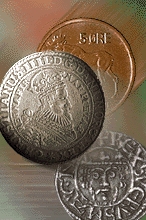|

Here you can see examples
of 16 different types of Norwegian coins through 1000 years. |
|
It is
not possible to categorise the large variety of coin types with a single
formula. The main function of the coin's motif is to provide information
about the identity of the coin, that is its issuing authority, the place
of issue and its value. For coins intended for local circulation, people
needed to be able to distinguish new coin motifs from older issues and
from those of neighbouring states. Coins for international trade had to
be provided with exact and detailed information. Different production methods
could also form the basis of separate coin types. The most typical example
is the bracteates from the Middle
Ages that is clearly distinguished by its thin blanks and single-sided
design.
A number of considerations have motivated
the design of different coin types. These include:
 |
The coin as an official object representing a value guaranteed by the
issuing authority or the state. Portraits and heraldic
symbols (national coat of arms, the state lion, family coat of arms) were
therefore the most common motifs on coins. Coins often acted as instruments
of propaganda for the state. |
 |
Imitations of recognised foreign coins. In the Viking Age and the Middle
Ages, issuing authorities were often inspired by foreign coins when designing
their own. |
 |
Various secondary symbols, initials and marks were used to allow the
issuing authorities more efficient control of their standards being met
with regard to weight and fineness. |
 |
The aesthetic aspect. Beautiful objects have always been valued. All
epochs in numismatic history offer examples of coins with great artistic
merit. |
 |
Inscriptions. The purpose of inscriptions is primarily to inform the
users of the identity of the issuing authority, the place of issue, the
coin's value, and the area in which it is legal tender. |
 |
Coining methods. Different production methods can give rise to separate
categories of coins such as, for example, bracteates and klippen. |
|

 Coin types
Coin types

 Coin types
Coin types
